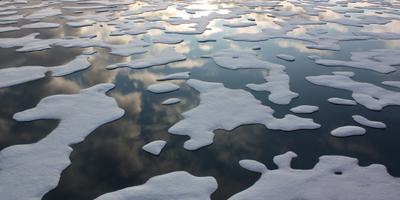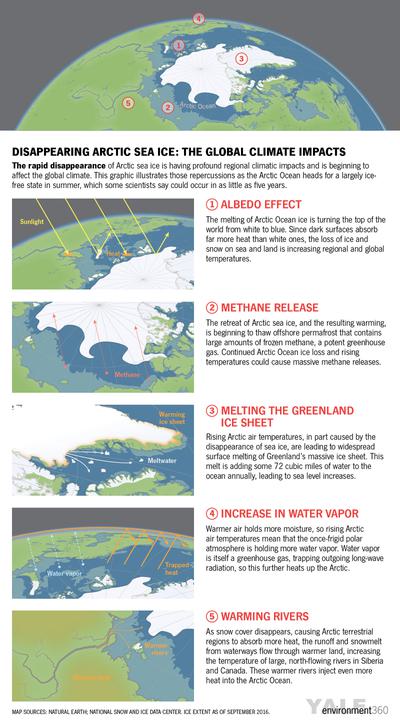Few people understand that the Arctic sea ice “death spiral” represents more than just a major ecological upheaval in the world’s Far North. The decline of Arctic sea ice also has profound global climatic effects, or feedbacks, that are already intensifying global warming and have the potential to destabilize the climate system. Indeed, we are not far from the moment when the feedbacks themselves will be driving the change every bit as much as our continuing emission of billions of tons of carbon dioxide annually.
So what are these feedbacks, and how do they interact? The most basic stem from turning the Arctic Ocean from white to blue, which changes the region’s albedo — the amount of solar radiation reflected off a surface. Sea ice, in summer, reflects roughly 50 percent of incoming radiation back into space. Its replacement with open water — which reflects roughly 10 percent of incoming solar radiation — is causing a high albedo-driven warming across the Arctic.
When covered almost entirely by ice in summer — which the Arctic was for tens of thousands of years — water temperatures there didn’t generally rise above freezing. Now, as the open Arctic Ocean absorbs huge amounts of solar radiation in summer, water temperatures are climbing by several degrees Fahrenheit, with some areas showing increases of 7 degrees F above the long-term average.
Such changes mean that a system that was once a vast air conditioner has started to turn into a heater. Just how much extra heat are the dark waters of Arctic Ocean in summer adding to the planet? One recent study estimates that it’s equivalent to adding another 25 percent to global greenhouse emissions.
To appreciate the complexity of these feedbacks and interactions, one need only look at the growing role played by waves and storms in the melting Arctic. With more of the Arctic Ocean becoming ice-free in summer, more waves are being generated. In summer, this increased wave action breaks up large ice floes into smaller fragments and hastens their melt. Then, in autumn, larger storms fed by open water cause wave-induced mixing of the Arctic Ocean, which brings up heat absorbed during the summer. This warms the water, making it harder for ice to form in the fall. I observed this phenomenon last September and October aboard the University of Alaska research vessel Sikuliaq in the western Arctic Ocean. After the warm summer of 2015, the advance of winter ice was slow and sporadic, apparently held back by the quantity of heat in the water column.
Yet another albedo-related effect with important global climatic repercussions is now unfolding in the Arctic. As ice-free Arctic waters have warmed, in turn warming the air above them, these rising temperatures have spread over land. This is an important factor in the increased melting of snow in Arctic terrestrial regions. Today, in midsummer, the Arctic land area covered by snow has decreased by several million square miles compared to five decades ago. These now-dark lands absorb more heat and further warm the Arctic — and the planet.
Also, as the tundra and boreal forests heat up, runoff from snowmelt and waterways runs through warmer land, increasing the temperature of the great Arctic rivers such as the Mackenzie in Canada and the Ob, Lena, and Yenisei in Siberia. The warmer waters of these north-flowing rivers discharge into the Arctic basin, injecting more heat into the polar ocean.
By my calculations, the terrestrial warming in the Arctic is roughly equivalent to a 25 percent boost in global CO2 emissions. This, combined with the warming caused by the loss of Arctic sea ice, means that the overall ice/snow albedo effect in the Arctic could add as much as 50 percent to the direct global heating effect of CO2. Scientists can debate the potential magnitude of such increases. But there is no doubt that they will be significant — vividly illustrating how the Arctic can become a driver of, rather than just a responder to, global climate change.
The most worrisome feedback involves the release of seabed methane from the continental shelves of the Arctic Ocean.
The list of feedback effects on the global climate from diminishing Arctic sea ice goes on. As ocean and air temperatures in the Arctic rise, this adds more water vapor to the atmosphere, since warmer air holds more moisture. Water vapor is itself a greenhouse gas, trapping outgoing long-wave radiation and holding heat closer to the surface of the earth. With air temperatures rising in many parts of the Arctic by several degrees F in recent decades, water vapor concentration has gone up by more than 20 percent, adding to Arctic warming.
Rising air temperatures over open Arctic waters in summer are also heating up the Greenland ice sheet. Until the 1980s, the Greenland ice sheet did not experience extensive summer melt. The melt then began at low altitudes, and in recent years has spread to the whole ice sheet. In July 2012, for example, 97 percent of the Greenland ice cap experienced surface melting, according to remote sensing by satellite.
The meltwater does not just remain on the surface to refreeze in autumn. It plunges down into the ice sheet through large holes called moulins, lubricating the ice sheet bed and causing glacial advance to accelerate, doubling in speed in some cases as glaciers calve more icebergs into the ocean. Greenland is now the largest single contributor to global sea level rise, its melting ice cap adding some 300 cubic kilometres (72 cubic miles) of water per year to the ocean. The low estimates of sea level rise by the end of the century — two to three feet according to the Intergovernmental Panel on Climate Change (IPCC) — are being revised upwards, with serious implications for policymakers who must plan the defense of low-lying cities like Miami, New Orleans, London, Venice, and Shanghai, or of defenseless coastlines like Bangladesh.
But the most worrisome feedback, which could lead to catastrophic effects in the near future, involves the release of seabed methane — a potent greenhouse gas — from the continental shelves of the Arctic Ocean.
The Arctic Ocean is unusual in that, while its abyssal depths are great (13,000 feet or more), it is surrounded by wide continental shelf seas only 150 to 300 feet deep. Most of these — the East Siberian, Kara, Laptev, and Barents seas — lie to the north of Siberia. Until this century, most of these Arctic continental shelves were covered with sea ice even in summer, and this prevented the water temperature from rising above 32 degrees F. During the last decade, however, the summer sea ice has retreated from the shelves, allowing the water to warm up into the high 30s. The warmer water, extending to the seabed, thaws the offshore permafrost that has been in place since the last Ice Age. Underneath it is a thick layer of sediment containing large amounts of methane in the form of solid methane hydrates; these have a cage-like crystal structure in which methane molecules are surrounded by ice.
The release of the overlying pressure allows the hydrates to disintegrate and turn into gaseous methane, which bubbles up through the water column in intense plumes and is released to the atmosphere. This release is already causing global methane levels to rise after being flat through the early years of this century. The fear is that a larger portion of the methane will be released from the sediments. And although methane only remains in the atmosphere for a decade or so (unlike CO2, which can linger for centuries), it traps heat 23 times more efficiently per molecule than carbon dioxide.
These changes represent a spiritual impoverishment of the earth, as well as a catastrophe for humanity.
The Russian scientists investigating the offshore plumes (joined recently by German and Swedish expeditions) fear that a pulse of up to 50 gigatons of methane — some 8 percent of the estimated stock in the Arctic sediments — could be released within a very few years, starting soon. If this happened, model studies show that there would be a virtually immediate warming of 1 degree F, with accompanying massive costs to the planet.
What is the risk of such an outbreak? Many scientists say it is low, although those who regard it as high are the very scientists who have actually done the observational work in the East Siberian Sea. The IPCC ignores this risk, but does go into the likely result of the thawing of permafrost on land, which would itself set off a total methane emission of a similar magnitude, albeit spread over decades.
Other feedbacks from the loss of Arctic Ocean ice — ranging from a possible slowdown of the so-called “global ocean conveyor belt” to major shifts in the northern hemisphere’s jet stream — could also have serious climatic impacts.
What I am trying to offer in this tale of apparently unremitting gloom is a wake-up call rather than a statement of despair. What is taking place in the Arctic reinforces the conclusion of many scientists that last year’s Paris agreement to limit global warming to 2 degrees C is unrealistic so long as it only involves the reduction of CO2 emissions. As the various Arctic climate feedbacks show, we are fast approaching the stage when climate change will be playing the tune for us while we stand by and watch helplessly, with our reductions in CO2 emissions having no effect in the face of, say, runaway emissions of methane.
What is needed today is a widespread global campaign to actually remove carbon dioxide from the atmosphere using techniques like direct air capture. In my view, initiatives to devise economically acceptable methods for carbon dioxide removal from the atmosphere should be the most important concern of science and technology. The success of these efforts will mean the difference between the prospect of a positive future for mankind and the certainty of a descent towards climate-driven chaos.
In my professional lifetime, I have witnessed the transformation of the top of the world from a beautiful ice-bound expanse of wilderness to a region now characterized by warming and melting on all fronts. These changes represent a spiritual impoverishment of the earth, as well as a practical catastrophe for humanity. The time for action has long since passed.




